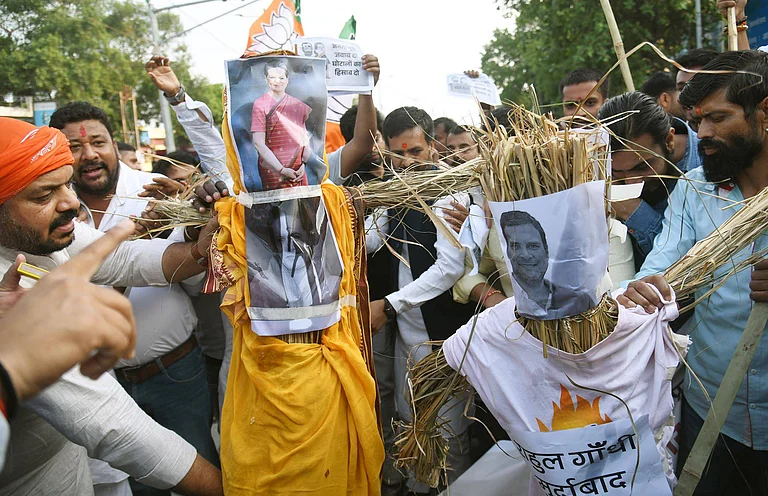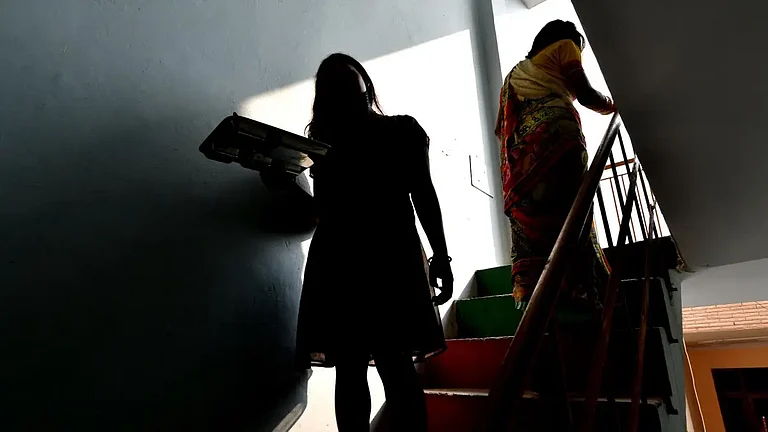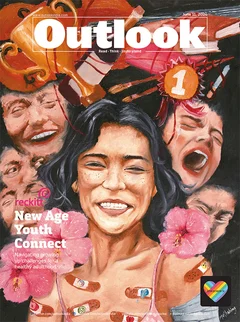I remember the shock and horror as I read the first article on Section 377 of the Indian Penal Code way back in 1991. Having founded the country’s first gay magazine, Bombay Dost, I had commissioned the first piece on Section 377 and what it meant for the LGBTQIA+ communities. The author was the learned criminal lawyer Shrikant Bhat who also lectured at the Government Law College, Mumbai. Just to make sure that he was not misunderstood, Bhat added the disclaimer “I am a heterosexual” to his piece, reflecting how circumspect mainstream society was handling the subject. This was 1991.
His conclusions were clear: We were outright felons and deserved 10 years of rigorous imprisonment or life sentence. Buggery, sodomy or non-vaginal sex were criminalised, and all it needed was penetration to prove it, which ironically is also a gay obsession. That first article in Bombay Dost started a chain reaction in the nascent Indian LGBTQIA+ community. And it took decades to get it off the statute books. Well, not struck down but read down, which meant consenting adults would be outside its ambit.
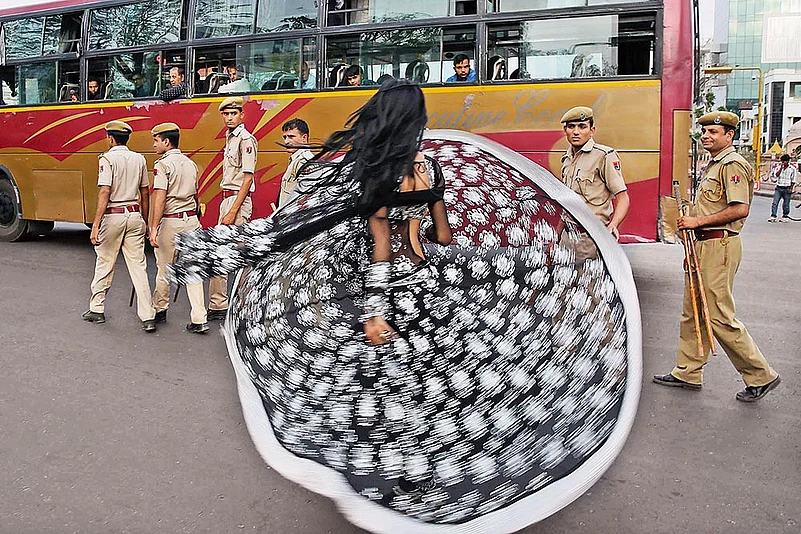
It would take a book to record the struggles of those years, including significant chapters on how the community’s politics emerged from the underground to carry the fight out in the open, the goings-on in Parliament and the judiciary. So, I will cut to the chase and restrict myself to the main persona involved over the last three decades.
Gay magazine Bombay Dost was greeted with particular interest. Older gay men were astonished to see such a magazine existed and discover that there were other men like them in India
Before the LGBTQIA+^ struggle, I had served as a documentation officer for the Bombay Municipal Corporation’s unique project around Kamathipura’s 22,000 sex workers, another socially stigmatised population. I had attended those intense International AIDS Conferences in Montreal in 1989, where it was unsettling to see gay men protesting the Reagan neglect of homosexuals who were dying like flies in San Francisco. Their protests mercifully were not entirely in vain, with the condition being renamed from GRID (Gay Related Immunodeficiency Disease) to HIV/AIDS. By the time I returned, half of my friends in San Francisco had died of AIDS.
In India, it was the solitary couple of determined lawyers, the dashing Anand Grover and his wife Indira Jaisingh, leading the fight against the AIDS stigma and Section 377. The generally unflappable Anand Grover had hauled the Goa Government to court, outraged that his friend Dominic D’Souza had been socially shut out for being HIV positive. A furious Anand with the help of another friend, Dr. Ishwar Gilada, ensured his admission at the Breach Candy Hospital in Bombay. However, no nurse went near the room where Dominic was admitted, leaving him to die.
It was Bombay Dost again, which warned the gay community about HIV in its very first edition. The magazine’s classified pages were greeted with particular interest. Older gay men were astonished to see such a magazine and discover that there were other men like them in India.
The Delhi High Court altered the Constitution in two notable respects, changing sex to also mean sexuality and giving a new definition to privacy, along with introducing the concept of Constitutional Morality
Anjali Gopalan of the Naz Foundation initiated the fight against Section 377, reaching out to Anand Grover’s NGO, the Lawyers Collective, for help. The case was fought out in the Delhi Court, from where it went to the Supreme Court, which whacked it right back like a tennis ball. Finally, on July 2, 2009, Justice A.P. Shah gave the momentous judgement reading down Section 377. It was moving to see grown up men crying as they read the judgement in court though we knew it was not the end.
The notable fact was that the Delhi High Court had subtly interpreted and altered the Constitution in two respects. It had changed sex to also mean sexuality, and it had given a totally new and novel definition to ‘privacy’ itself, along with introducing a new concept called “Constitutional Morality”. Few noticed it, but nearly everybody welcomed it. Anand had dug up evidence showing that homosexuality had historically flourished in India and had never been stigmatised as in Abrahamic religions.
The judgement came exactly a decade after I participated in India’s first Pride walk in Kolkata, organised by my friends and comrades Owais Khan, Pawan Dhall, and Ranjan. The stars seemed to be smiling at us finally. But that was until the Delhi judgment was overturned by Justice Singhvi on December 11, 2013. This judgement was critiqued by many senior lawyers as unsustainable and likely to fail the test of review. And that is exactly what happened. On the “Day of Outrage” at Bombay’s famous Maheshwari Garden, hundreds of the LGBTQIA+ community members rose against the judgement.
Grover and his assistant, Tripti Tandon, met the community leaders at the Constitution Club in Delhi and explained how they proposed to approach the Supreme Court for a review. They explained that very few Supreme Court judgements were ever overturned on review, but there was a slim chance, particularly because several progressive-minded judges had filled the chairs at the apex court.
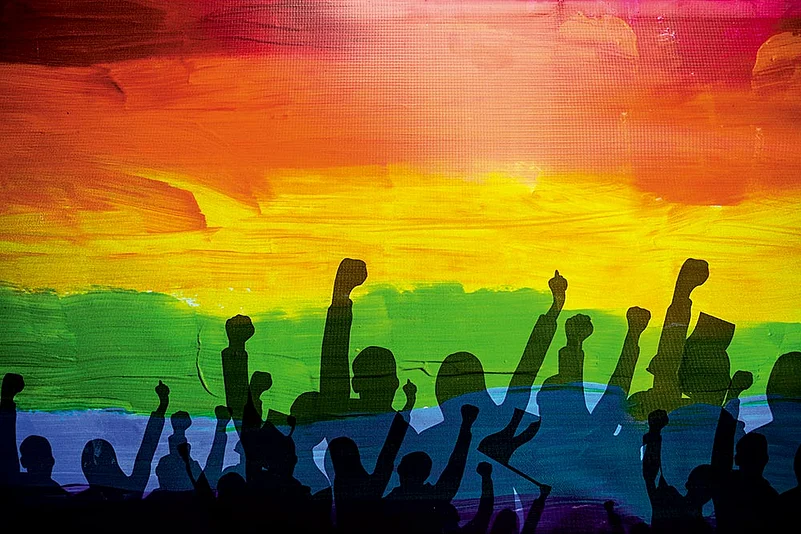
In 2006, I started my job as a Programme Officer for the National AIDS Control Programme (NACO) at UNAIDS. My supervisor was Denis Braun, a Frenchman whose passion for Indian culture was enough to give most Indians a complex. He suggested that I apply for a separate grant from the Global Fund to work with gay and transgender communities, which was an excellent opportunity. At NACO, we were lucky to have Sujatha Rao, who was a very hands-on Director General. Although sometimes referred to as “Fraulein Hitler” behind her back due to her tough approach, Sujatha Rao was a fantastic leader who balanced firmness with genuine care.
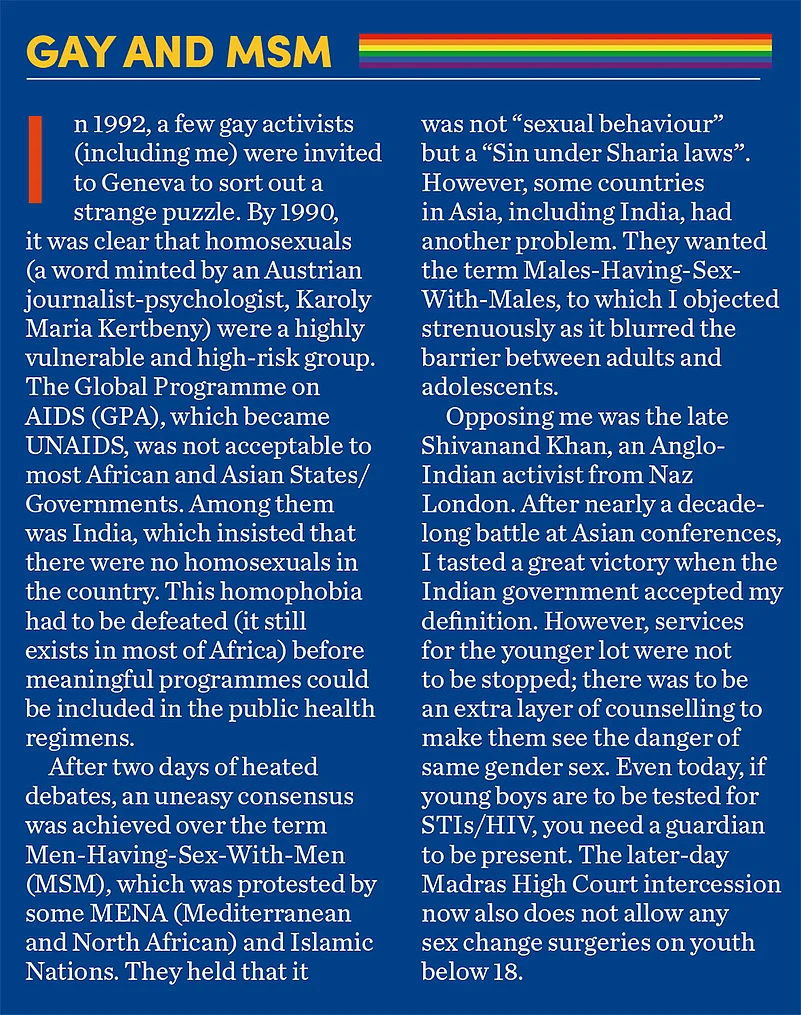
I still remember an argument with her about a special budget for lubricants in condoms. Shiv Kumar, the director of SWASTI, an NGO based in Bangalore, was clearly on my side. Sujatha Rao wanted the lubrication to be inside the condoms, while I advocated for separate sachets of lube bundled with the condoms. She retorted, ‘What if you guys do not use the lube at all? “That’s why the lube needs to be inside.” In my view, separate lube sachets made sense because they had to be applied on the condom’s surface to be helpful. As the argument dragged on, it became clear that Sujatha Rao knew little about how condoms are worn. When I said the lube also makes the area more conducive for penetration, she was horrified. “Look, I am not paying for your pleasure.”
Finally, I snapped: “Well, Sujatha Rao, all the people NACO deals with have sex for pleasure. No man goes to a redlight area to make babies. So there. Come on; the lube is a few million dollars well spent as it could encourage the communities to promote it with social marketing”. She was so stubborn that I went home and got drunk. She did not sanction that amount, and Shiv had to cut it out of the budget.
This is just one of my many clashes with NACO’s top brass, many of which I lost, notably the one regarding gay men and transgenders being turned away even from free blood donation camps because they were considered ‘high-risk’ donors. I had an issue with a question in the donor form that asked whether the donor had had any risky sexual encounters. If all men answered this question honestly, most of them would be ineligible for donation, I argued. However, I was outvoted, and unfortunately, even today, homosexuals are not allowed to donate blood.
I scored my biggest wins at the UNAIDS during the lunch hour, which was marked by open, often uproarious, discussions about sex, sexuality and gender, some of which yielded results. For example, following arguments on circumcision and transgenders, UNAIDS changed its policy on toilet access to transwomen. That policy change was, however, reversed later after the women complained that most transgenders were pre-ops and did not clean the toilet after use.
We need ASHA workers to be more sensitive about female and male sex workers as gender ratios change and more women join the workforce. Only an LGBTQIA+ trained cadre can do this
It was a bit of a shock to return to Bombay. Although it was good to be back, I noticed a huge gap between the policies made in Delhi and their execution in the states. The community was in high spirits after the final Supreme Court judgement on September 6, 2018, regarding marriage equality. However, there were no coordinated petitions, community meetings, or consultations. Instead, there were screaming debates about appropriate pronouns and whether transwomen should be allowed to compete in men’s athletic events. The quality of discourse in the community had deteriorated, and there was cut-throat competition for press coverage and corporate lectures on diversity and inclusion. Unfortunately, tokenism was upending real representation, and the community efforts did not seem to resonate with the reality on the ground.
The Supreme Court judgement has specifically asked the government to educate people about sex, sexuality and gender, which would allow the LGBTQIA+ communities to pursue serious study and research on these three subjects. Incidentally, these subjects have dedicated faculties in the world’s leading universities. The main academic centre for this could be the Institute for Research in Reproduction (IRR) in Bombay, which has the brilliant Dr Deepak Modi as part of its faculty. The Education Ministry must revise all medical textbooks which still refer to homosexuality as a perversion and a mental disease. The best brains in the LGBTQIA+ space need to be trained to handle the mental health epidemic, and it would be great to have someone like Zainab Patel starting a whole faculty on transgenders and their issues. We need teachers for police training colleges to stop the violence against gay men and transgenders, we need counsellors from within the PTAs to be attached to schools and colleges where they still think oral sex is kissing, and we need to ensure that there is no compulsory surgery on children till they are 18 years of age.
We need our Panchayat ASHA workers to be more sensitive about female and male sex workers as gender ratios change and more women join the workforce. I think only an LGBTQIA+ trained cadre can do this. We have miles to go, and I think India can take the lead. Our AIDS prevention programme is among the best-rated in the world, and it’s time the community picked up the baton. It is not can we but when will we.
MORE FROM THIS ISSUE
The author is a journalist and LGBT rights activist








